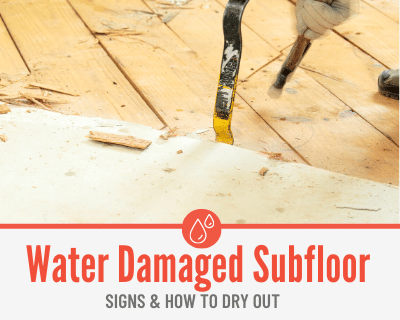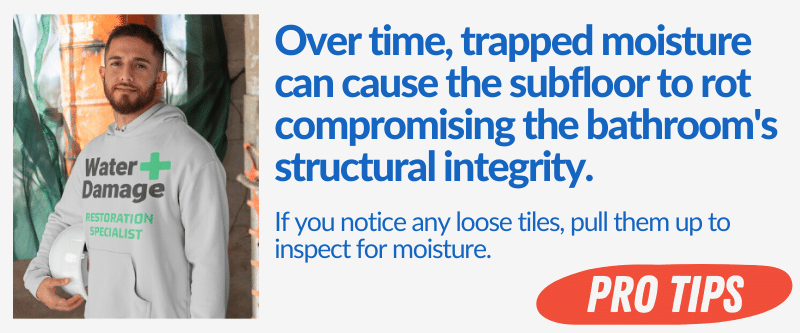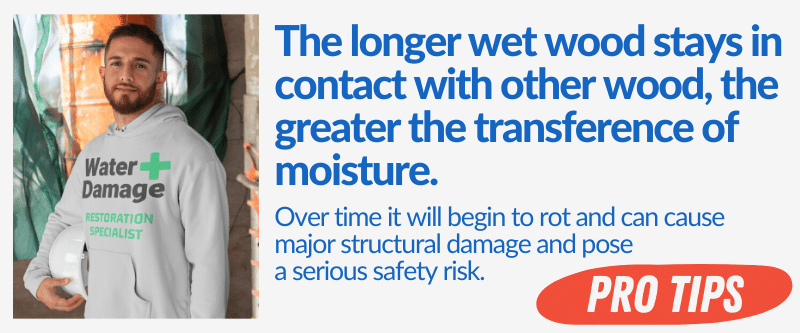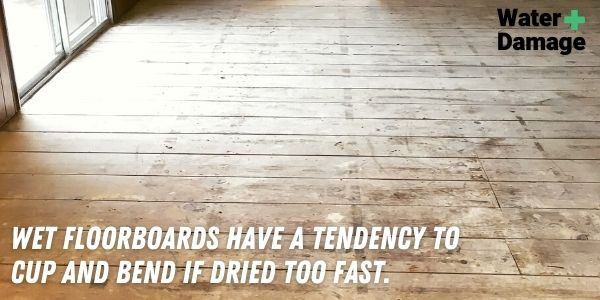Worried your subfloor might have gotten wet?
In this guide you will learn:
- How to tell if your subfloor might be wet,
- Common causes of wet Subfloor,
- What happens if Subfloor gets water damaged,
- How to Dry out your Wet Subfloor.

How to Tell if Subfloor Might be Wet
Wet Subfloor In kitchen
- If your floors are sunken or uneven in areas
- If you notice a soft spot when you take a step on wood flooring
- If your floorboards squeak loudly
- If the room smells musty
Soft spots on wooden flooring could indicate that the panels below have begun to weaken.
Loud squeaking when you walk across the floor is caused when the nails that are connecting the floorboards to the subfloor have begun to pull loose.
Commonly, kitchen floors become wet due to a leaking, damaged pipe underneath the sink. Another common cause one of the pipes within the surrounding walls is damaged, and water has begun to seep through.
Wet Subfloor In the basement
- A buildup of moisture at the base of the walls
- Water spots and discoloration of the drywall
- “Efflorescence,” which is when what looks to be white powder appears on the floor and walls
- Wallpaper or paint beginning to flake and peel off
- A damp, musty odor, which could indicate the presence of mold or mildew
As a result of wet subflooring in the basement, high humidity and condensation on windows can occur.
More often than not, basement floors become wet when rainwater or melted snow is improperly routed away from the house.
Excess water seeps down along the foundation, and comes up through the compact soil near the base of the house, which then gets wicked further upward and into the flooring.
This can cause a number of issues, not only with your flooring but your walls as well.
Wet Subfloor In the bathroom
- Recurring mold or mildew
- Damp, musty smell
- Soft, “spongy” flooring
- Gaps in the tile or caulking around your tub or shower
- Mystery stains
One of the most common causes of bathroom subfloors getting wet are water splashes from the shower or tub.
Other causes could include damaged pipes, whether in the floor or under the sink, or an improperly sealed/installed toilet.
Signs your toilet is the cause include…
- stained or damp floor around the toilet
- toilet is leaking from the bottom of the tank
- there is a foul sewage smell
Signs its coming from under your shower include…
- damage to the ceiling in the room beneath it
- tiling or grout inside the shower is damaged or coming apart
- grouting at the base of the tub along the floor and walls is coming apart

Under tile
- Mold and mildew growth
- Tiles beginning to loosen and lift away
- Damp, musty smell
- Cracked or damaged grout
If water is getting under tile flooring, it will likely result in mold or mildew growth, which will eat away at the grouting or mortar even more.
If the tiles are loosening from the subsurface and beginning to lift away on their own, that is a clear indicator there is water damage underneath.
Under vinyl
- Adhesive has begun to deteriorate
- Visible ridges, bumps, and bubbling
- Seams beginning to open and separate from each other
- The flooring looks discolored
- Flooring has begun to warp and buckle
Moisture getting under vinyl flooring may cause it to start lifting, whether its glue-down or floating vinyl.
If you notice bubbles beginning to form in the middle of the vinyl floorboards, that is a clear indicator of the presence of moisture underneath.
As vinyl flooring begins to separate, it will allow more moisture from external sources in, which will compound any damage that’s being done.
As in almost all cases, mold or mildew may begin to grow beneath the vinyl, causing a musty smell in the room and further indicating water damage.
Under hardwood
- Cupping or crowning of the floorboards
- Warping or buckling
- The floor finishing has grown discolored
- Persistent condensation accumulating on the surface
- Infestation, such as with termites or other pests
Termites and other such pests thrive in moisture-rich environments and could indicate a buildup of water within the wood.
As the wood gets wet, it can begin to either crown or buckle, causing the planks to separate and resulting in an uneven surface.
If droplets of water continuously form on the hardwood floor’s surface with no apparent source, it may be an indicator that there is excess moisture within the boards.
Use of a thermo-hygrometer can rule out whether or not a high relative humidity is causing said condensation.
During construction
- If a floor covering fails to bond or delaminates
- Any cracking or bubbling of resinous floor coatings or other floor coverings
- Growth of mold or other pathogen growth, either on top of the concrete or beneath the flooring
- Moist or “weeping” walls around the foundation
- “Efflorescence,” or the buildup of a white powder looking substance
Incorrect installation of moisture barriers during construction can result in water getting through, and subsequently causing damage to not only the foundation of your home but your subfloor as well.
The presence of black stains could indicate the growth of mold or mildew, and will accompany a musty smell in the area.
If you’re installing tiled or vinyl floors that require gluing, moisture seeping into the flooring could result in adhesion failure, and result in the flooring not adhering to the subfloor properly.
Wet Subfloor?
Call 844-488-0570 for a Risk Free estimate from a Licensed Water Damage Restoration Specialist in your area.
We Can Help Dry out & Repair Water Damaged Subfloors!
What happens if the subfloor gets wet?
Different types of subfloor can pose their own unique issues when it comes to water damage. Commonly, subfloor falls into one of four types.
Plywood subfloor water damage
Plywood is made by laminating thin layers of a softwood together with powerful adhesives, such as polyurethane and the like.
The glue itself may be waterproof, but the wooden layers are not, and when exposed to moisture will swell and often become warped or deformed.
If the problem is ignored for a prolonged period of time, the wooden layers will begin to separate, compromising the structural integrity of the subflooring and the floor as a whole.
Plywood is a common material used in construction of basement walls and subfloors, so it is of the utmost importance you take action at the first signs of water damage.
OSB/Particle board subfloor water damage
OSB, or Oriented Strand Board, is often mistaken for plywood but has different characteristics. OSB is made by layering pieces in a certain way to produce a strong, waste-free board.
Particle board on the other hand has finer wood chips with no specific direction. If Particle board subfloors get water damaged this can get extremely dangerous.
Both are glued together with a strong adhesive such as polyurethane, but whereas plywood piles softwood on top of each other, OSB is made by carefully layering hardwoods on top of each other.
One of the downsides of OSB, unfortunately, is it is significantly more prone to water damage than plywood. When penetrated with moisture, the ends have a tendency to significantly swell, which can cause greater issues.
Due to its lack of waterproofing, OSB also has a tendency to rot after a while. It can take several years, but is a common occurrence all the same, so its best if kept dry and safe from any potential sources of moisture.
Concrete subfloor water damage
Concrete flooring is often overlooked for potential moisture damage, because most people wrongly assume it can’t hold moisture.
This can be a costly mistake that results in the delay or ruination of construction or remodeling projects.
If excess moisture in concrete subfloor is allowed to build up, it can lead to serious problems such as failure of flooring to adhere properly, discoloration in any tiling or grout laid on it, bubbling or separation of any sheet vinyl adhered to it, or buckling and crowning of wooden floor planks.
Even if it’s an old slab, which contractors may assume to be dry, it can still wick up water and should be tested for concrete moisture before beginning any remodeling projects.
Floorboard water damage
As is the case with any hardwood flooring, water is the enemy of floorboard subfloor. Wood is porous by nature, and any moisture that manages to permeate it will be absorbed.
Even if the wood has been sealed and waxed, while that will add to the wood’s water resistance it can’t prevent moisture absorbance completely. Wax and sealant are designed to give you extra time to clean up the water or spill, and get the flooring dried out.
If allowed to continue to absorb water, floorboard subfloors will crown and buckle, just like regular hardwood floors, and over time nails will come loose and cause flooring to squeak.

Does wet subfloor needs to be replaced, or can it be dried out?
If you’ve determined that your subfloor has taken on water or might be water damaged, the next step becomes determining whether it can be fixed/dried out, or if it needs replaced. When determining if it needs replaced, here’s some useful pointers to help make that decision.
- If your floor squeaks alarmingly loud when you walk across it, that is an indication the nails have come loose and are rubbing against the wood. This means the subfloor has begun to warp or twist, and even if dried could still cause damage to your flooring, or worse yet the joists themselves.
- Sections of your floor that have begun to sink between the joists are a sure sign there’s a more serious issue lying underneath. This commonly occurs when moisture has caused deterioration of the wood, or when the subfloor is improperly installed to begin with. Either way, the issue will need to be addressed, and the subfloor will need to be replaced.
- Cupping or crowning floorboards are a visible indicator that the flooring needs to be replaced. If the floorboards begin to curl along the length of the board, it’s most often a result of excess moisture, and should be addressed sooner rather than later.
- If tiles are cracking and separating or coming loose, and the back of the loose tiles has dried thinset on it with no sign of trowel marks, the issue likely lies with the subfloor. Most commonly this will be a moisture issue, but in some instances can be a result of the wrong material being used. Whichever happens to be the case, you’ll want to look in to replacing it before reapplying any missing tiles.
In most instances, you should listen to your instincts. If you’re worried that leaving the subfloor as it is will be dangerous or cause issues, it’s probably time to replace your subfloors.
How to dry out wet subfloor
If you’re confident that the moisture isn’t that bad, and you’ve mitigated the source of it, attempting to dry out the subflooring can be a more cost-effective option. Here we’ll go over how to dry out different types of subfloor.
Drying out Plywood subfloor
As stated above, first you want to make sure the source of the water leaking in has been dealt with, otherwise the plywood subfloor will never dry. From there, you’ll want to block off any passageways and isolate the area to decrease how long it takes to remove the moisture.
Make sure any surface water has been wiped away from the plywood subfloor, then get a dehumidifier set up and turn it up to the highest setting.
Placing as many fans as possible in the room to keep air circulating in the area is also important. Moving air will help remove moisture from the wood, and aid in the drying process. If you can, point them at the wet areas of the plywood directly.
As with the humidifier, set them to their highest setting, and leave them running until the floor is completely dry.
Drying out OBS subfloor
Being similar to plywood in some regards, similar methods to dry out OBS subfloor should be employed. Humidifiers at the highest setting running constantly, and be sure to empty them frequently.
Point fans at the wet areas of subfloor, and leave them on the highest setting as well.
OBS is more susceptible to swelling and other damage than plywood, though, so you’ll want to monitor it closely, and in some instances, it can take days to fully dry out.
Keep your drying setup going until it looks and feels dry, at which point it is recommended you test it with a moisture meter. Insert both probes into the OBS and wait for the reading, and repeat the test twice for every hundred square feet of wet subfloor.
Drying out Concrete subfloor
When water soaks in to concrete subfloor, it can take much longer to dry out due to the environment its in. Concrete subfloor is most common in basements, where humidity can slow the drying process. It is crucial you ensure any source of moisture getting in is tended to before attempting to dry concrete floors out.
That being said, the common theme here continues; dehumidifiers running constantly and powerful air circulation are a must. Open the windows if you have any to allow humid air to escape and help dry out the room.
If there was serious flooding or there was a major leak such as a pipe bursting, make sure your electrical wiring has been inspected and cleared by a professional electrician before plugging in anything, even the aforementioned dehumidifier and fans.
Drying out Floorboards
Floorboard subfloors are a bit different than the others, although the main components will be familiar by now. You’ll want to wipe off any standing water immediately, because the longer there is standing water the more the flooring can become damaged.
If there is any dirt or debris leftover, such as from flooding, you’ll want to scrub and disinfect the wood.
Mud, silt, and the like will have made itself at home in any small crevices, and you’ll want to make sure its all removed. This should be done beforehand, otherwise the drying process will have to be done all over again.
Once the floors are clean, you guessed it; fans and dehumidifiers. They really are your best friends when it comes to getting moisture out of your subflooring.
Turn them all on to their highest setting, and give them time to do their thing. Keep an eye on the floorboards as they’re drying, and make sure they aren’t bending, warping, or buckling during the process, in which case they’ll likely need to be replaced.

How long does it take subfloor to dry out?
Different factors will have an effect on how long it takes your subfloor to dry out, including what type of subflooring and how much moisture they’ve absorbed.
Things like having multiple fans and dehumidifiers can speed up the process, but generally, you’re looking at anywhere from 24 to 96 hours for your subfloor to dry out completely.
You won’t want to rush this process, because the goal is to remove all of the moisture so that it can’t cause any further damage.
Ideally, you’ll only have to dry them out, but they’ll need to be fully dried before you can work on repairing or replacing them anyways. So it’s best practice to create optimal conditions, and give them the time they need.
What is the best subfloor for wet areas?
Most commonly, plywood is the material of choice among contractors and the like when installing subfloor in a bathroom. Exterior grade plywood, to be specific, as it has typically been treated against water, and has a high resistance to moisture and humidity.
Other materials like OBS can be more cost effective, but as stated before is less water resistant and is more susceptible to water damage.
Compared to plywood, OBS is also more likely to need replacing if damaged by water, so while the savings may be greater initially, it could wind up costing you more in the long run.
In some instances, such as basement bathrooms, you may not have a choice in the matter, as concrete may be your only option.
If that’s the case, and the decision has already been made for you, then there isn’t much else to consider. But in any instance where you’re given the choice of which subflooring to use, exterior grade plywood really is the best option.
When to call a professional
As a general rule, any time you feel uncomfortable performing a repair, or if you’re worried you might end up making the situation worse or causing further damage, don’t hesitate to contact a professional.
Particularly if there is a lot of water to remove.
If there is a small amount of moisture they have the equipment to remove the moisture without even having to take up your floor.
They also have industrial-grade drying equipment that many people just don’t have access to.
We have Water Damage Restoration Technicians that can help Dry out Your Subfloor and Repair any Water Damage.
For Disasters of all Sizes, available in 95% of the USA
